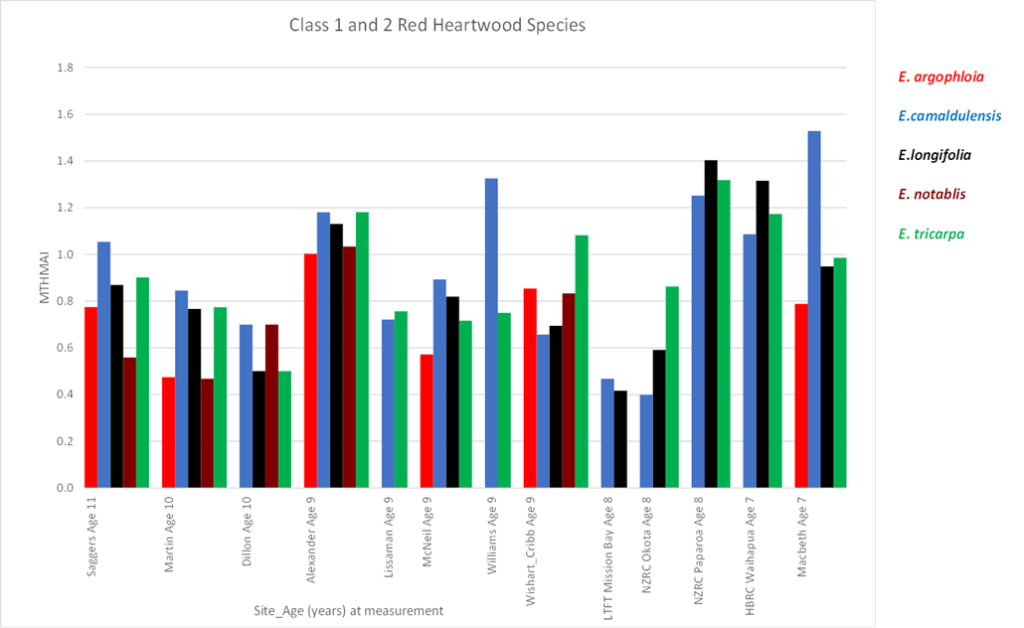Phone: 03 577 2395
C/- Marlborough Research Centre Trust, PO Box 875, Blenheim 7201


The five Class 1 and 2 red heartwood species being evaluated in NZDFI's demonstration trials are:
Comparative growth of the five species

Class 1 and 2 red heartwood species comparative growth Mean Top Height Mean Annual Increment (MTHMAI) across all sites.

Class 1 and 2 red heartwood species Mean Top Height Mean Annual Increment (MTHMAI) across sites and species.
E. argophloia - Queensland western white gum
E argophloia is a class 1 species included in NZDFI trials because of its deep red heartwood and perceived potential to survive and thrive on very dry sites.
The species shows variable productivity across sites. The most productive trial, Alexander, has an MTHMAI of 1.1m. The average MTHMAI is 0.8m.
Overall the species has been one of the least productive amongst those being tested in NZDFI trials.
For more information see:
----------------------------
E. cameldulensis - Red river gum
E. cameldulansis is included in all sites except one in the 2011-2014 trial series. It was selected for the NZDFI trials based on its extensive international use in plantations in dry regions.
There is high variability across sites. At its best (on the Macbeth site, North Canterbury), the MTHMAI is 1.5m. The average MTHMAI is 0.9m.
The species has been proven to be heavily defoliated by insects so growth rates have been difficult to interpret, and form is generally poor.
For more information on E. cameldulensis see:
----------------------------
E. longifolia - Woollybutt
E. longifolia was included in NZDFI trials because of its class 1 red heartwood, its possible suitability for North Island east coast environments, and some encouraging results in earlier New Zealand plantings.
It has a mean MTHMAI of 0.8m. Its best performance is at NZRC Paproa, with a MTH of 1.4m; the lowest productivity is 0.4m at LTFT Mission Bay.
Only one seedlot has been tested in NZDFI trials.
For more information see:
----------------------------
E. notabilis - Blue Mountains mahogany
E. notabilis was included in five 2011 trial site plantings only. It produces a dark red highly durable heartwood.
The species has performed poorly at all locations, with the best MTHMAI of 1.0 at Alexander (Hawkes Bay), and a poorest of 0.5m.
For more information about E. notabilis see:
----------------------------
E. tricarpa - Red ironbark
E. tricarpa produces dark red durable heartwood. It is closely related to E. sideroxylon (also called 'ironbark') and the two species are highly sought after in Australia.
It is a secondary species in NZDFI's breeding programme.
As with other species, results show variability between sites. It has a mean MTHMAI of 0.9m; the best performing site was NZRC Paproa with a MTHMAI of 1.3m.; the lowest productivity was at Dillon (0.5m MTHMAI).
NZDFI will continue to work with E. tricarpa as the species is perceived to have the best potential amongst the class 1 red heartwood species initially included in the breeding programme.
For more information see:
C/- Marlborough Research Centre Trust, PO Box 875, Blenheim 7201